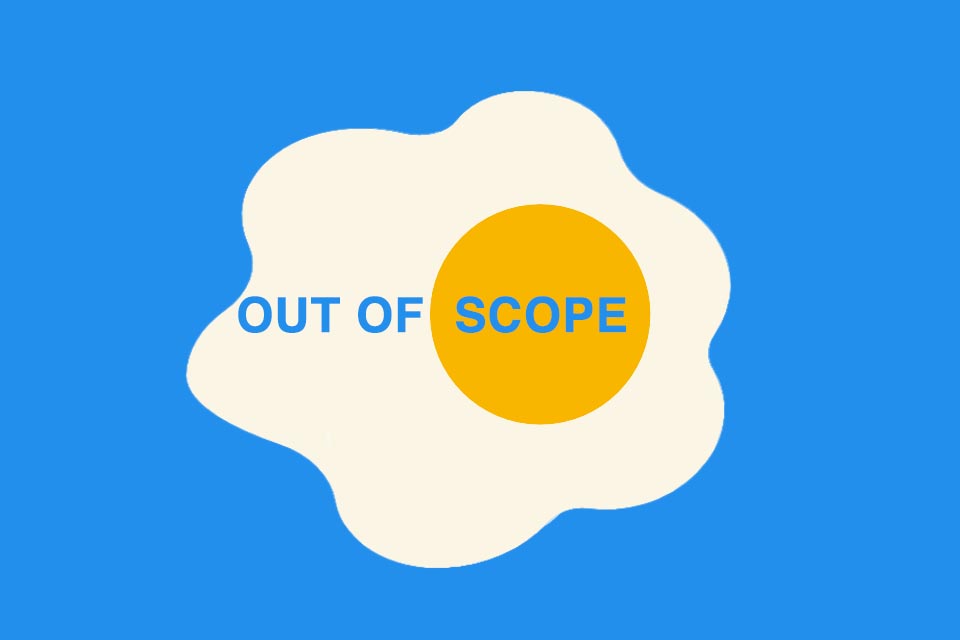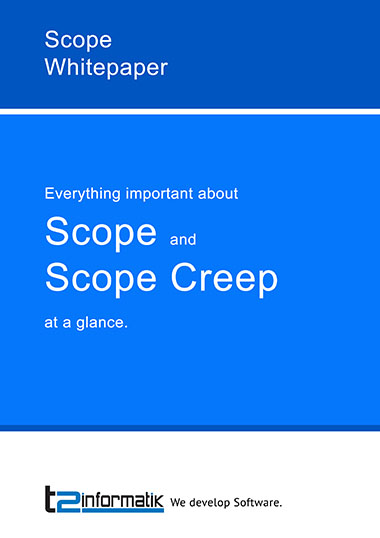What is the Scope?
Table of Contents: Definition – Scope in projects – Importance of requirements – Questions from the field – Download – Notes
Smartpedia: Scope has many meanings. In terms of projects, it is the work that needs to be done to deliver a result with defined characteristics.
Scope – a term with different meanings
There are various translations or different applications for the term scope. It is defined und used as
- range,
- frame,
- possibility,
- leeway,
- area of application or
- area of validity.
In the context of companies, scope is usually understood as the range of the project, the project object or the extent of performance.
The scope in projects
The correct definition of what is to be implemented in the course of a project is an essential success factor for good project management. The PMBOK of the Project Management Institute (PMI) defines the scope of a project as “the work that must be done to deliver a product, service or result with the specified characteristics and functions”. The scope management comprises six processes [1]:
- Plan Scope Management: Planning the process and creating a scope management plan.
- Collect Requirements Definition and documentation of stakeholder requirements.
- Define Scope: Develop a detailed description of the project scope.
- Create Work Breakdown Structure: Subdivision of the project deliverables into smaller units of work.
- Validate Scope: Formalise the acceptance of deliverables.
- Control Scope: Monitoring the ongoing process and managing changes to the project scope.
Simply put, scope refers to the “what” is implemented in a project or development. And this “what” is determined by requirements.
The importance of requirements for scope
Dealing with requirements is essential both for determining the extent of performance and for the actual development of products or services. Approaches and opinions on how best to deal with requirements vary.
The PMBOK, for example, defines various inputs, tools and techniques, as well as outputs. Inputs are
- the scope management plan,
- the requirements management plan,
- the stakeholder management plan,
- the project description and
- the stakeholder register.
Tools and techniques mentioned are
- interviews,
- working with focus groups,
- conducting requirements workshops,
- using creativity techniques,
- using decision-making techniques, questionnaires and surveys,
- observations,
- developing prototypes,
- benchmarking,
- using context diagrams and
- document analysis.
The findings from these tools and techniques flow as outputs into the requirements documentation and the so-called requirements traceability matrix.
Basically, it can be said that many of these tools can provide valuable services in traditional projects. But what happens in more agile situations when reacting to changes becomes more important than following plans? It is hard to imagine anyone finding the time to maintain a requirements traceability matrix. In such situations, agile requirements engineering becomes much more important. But not in the form that tools or techniques are omitted, but rather that additional methods are added. This aspect is emphasised by the two certification standards of the International Requirements Engineering Board (IREB): RE@Agile Primer and Advanced Level RE@Agile.
Of course, the extent of performance is also important in agile projects, but rather as a vision of a development and less as a concrete project object. Or in other words: the project object is defined and implemented cyclically, in short intervals. Transferred to Scrum, this means: the sprint goal manifests the scope of a sprint.
Questions from the field
Here you will find some questions and answers from the field:
What is a scope creep?
The increase in project scope after the start of the project due to uncontrolled changes without taking into account possible effects on deadlines, costs or employee utilisation is known as scope creep. In practice, such an expansion often occurs gradually. The reasons for this are, for example, inadequate definition of the project scope and unclear definition of objectives, unclear project requirements, inaccurate system context analysis, lack of transparency or poor communication between those involved.
What is a requirements creep?
The following reasons contribute to requirements creep:
- New requirements are added during the life of the project, often without formal approval or consideration of the impact on schedule, budget and resources.
- Already defined requirements are modified, extended or clarified, resulting in additional work.
- Changes and enhancements are often not adequately documented, leading to confusion and misunderstandings.
- Stakeholders, such as customers or management, may introduce new ideas or requirements during the project that the team tries to implement without going through the formal change process.
Requirements creep can have a significant negative impact on a project. Firstly, additional or changed requirements often lead to cost overruns as more resources and time are needed to fulfil the new specifications. This in turn can disrupt the entire project schedule and lead to significant delays. In addition, there is a risk of quality issues as the project team may try to implement the new requirements quickly, which can lead to errors or incomplete solutions. This situation can also lead to dissatisfaction among stakeholders, as misunderstandings about the project scope and unrealistic expectations can arise. Ultimately, requirements creep jeopardises the successful and timely implementation of the project and can affect both the efficiency of the team and the trust of the stakeholders.
What is a function creep?
Function creep refers to the gradual expansion of the use of technologies, systems or data beyond their originally intended purpose. This often happens without being intended by the original developers or users. A clear example of this is the movement data collected by mobile phones. Originally, this data is usually collected to improve the GPS service or to provide location-based services. Over time, however, the same movement data could be used for completely different purposes, for example to create movement profiles.
This extended use of data is often done without the knowledge or explicit consent of users, which raises significant privacy concerns. The transition from a harmless, useful service to a potentially invasive surveillance tool is typical of function creep and shows how important it is to set clear boundaries and regulations for the use of technology to ensure privacy and prevent abuse.
What is a feature creep?
Feature creep refers to the constant addition of new features to a product, which unnecessarily inflates the scope of the product without providing any real added value for the user. This process can have serious consequences for a product. Firstly, the constant addition of new features leads to the product becoming overloaded and losing clarity. Users find it increasingly difficult to use the core functions as they have to wade through unnecessary options and settings. This significantly worsens the user experience as the product becomes more complicated and less intuitive, which means that the original benefits are often lost in the plethora of unnecessary functions. In the context of software, this is referred to as bloatware.
In addition, feature creep leads to a waste of resources, as time, money and labour are spent on developing and integrating features that do not offer any real added value. These resources could be better used to optimise core functions or develop truly innovative solutions. An overloaded product can also damage a brand’s reputation, as users may switch to simpler and more user-friendly competitor products. Finally, the multitude of unnecessary features increases maintenance costs, as bug fixes and updates become more time-consuming and expensive. Overall, feature creep can therefore significantly jeopardise the long-term success and profitability of a product.
What is a scope leap?
Scope leap describes the shift in the strategic focus or tactical direction of an organisation, which leads to a complete change in the scope of the project. In contrast to scope creep, where the project scope is gradually expanded, scope leap is an abrupt change that redefines the entire project. This change is usually the result of crucial business decisions aimed at adapting to new market conditions, technological developments or changing customer requirements.
Scope Leap can have significant consequences for a project. The sudden realignment of the strategic focus often leads to a complete change in the scope of the project, which requires extensive rescheduling. This usually results in significant delays and cost increases as additional resources are required to fulfil the new requirements. The drastic change also increases the risk of uncertainty and errors, as the team has to adapt to unknown or less proven objectives. In addition, scope leap can lead to confusion and frustration within the team, as previous efforts are devalued and the new goals are not always clearly communicated. In extreme cases, scope leap can even lead to the project having to be cancelled or completely restarted if it is no longer feasible in its original form.
What is a scope grope?
Scope creep refers to an unclear or undefined project scope, often caused by a team’s inability to clearly define or articulate requirements. In such cases, there are only rough ideas about the project goals, which leads to the project progressing aimlessly. This condition can have serious consequences as it turns projects into ‘scope drifters’, ‘productivity spoilers’ or ‘promise stealers’:
- Without clearly defined goals, the project drifts along unstructured, leading to constant changes in direction and inefficient use of resources. The project moves forward, but without a clear direction or prospect of success. This is also referred to as ‘scope drifters’. [2]
- The lack of clarity about the scope of the project has a negative impact on the team’s productivity. Without clear guidelines, team members often work on irrelevant tasks or with the wrong focus, which leads to wasted time and frustration. This is known as ‘productivity spoilers’.
- An unclear project scope can also lead to unrealistic expectations or promises being made. However, these ‘promise stealers’ cannot be fulfilled as the exact requirements and goals are not defined, which ultimately undermines stakeholder trust.
Scope creep is therefore a dangerous condition in project management that significantly increases the risk of failure. Clear communication and careful definition of project objectives are crucial to keep the project on track and avoid the negative consequences of scope creep.
Can the extent of performance be visualised in a Gantt chart?
Notes:
Companies try to exploit production and cost advantages by using common production factors (machines, processes, labour, locations, etc.) in the manufacture of goods. This results in so-called economies of scope.
[1] PMBOK Sixth Edition
[2] Preventing Scope Creep, Grope and Leap from Killing Your Projects
If you like the article or would like to discuss it, please feel free to share it in your network. And if you have any comments, please do not hesitate to send us a message.
Here you will find additional information from our t2informatik Blog:




